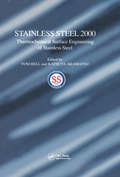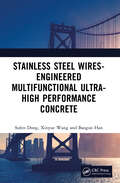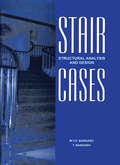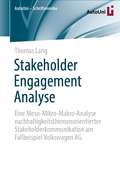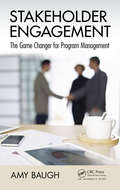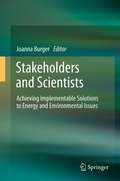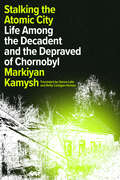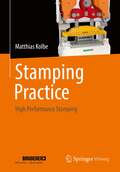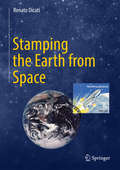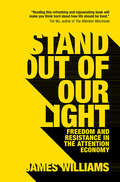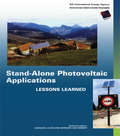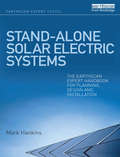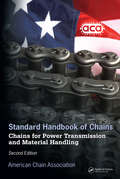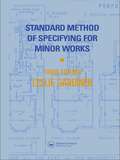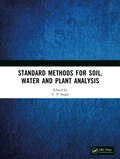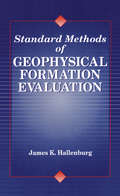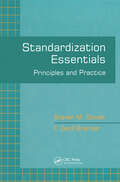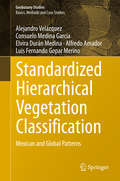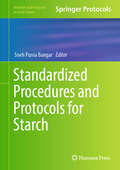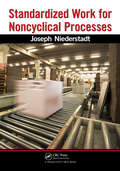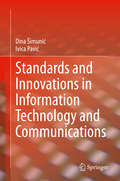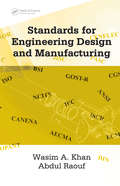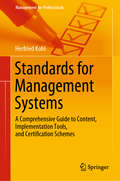- Table View
- List View
Staining and Varnishing
by David HollowayDavid Holloway takes you through all the steps needed to stain and varnish wood. Chapters start from the basics and takes the reader to more advanced staining tips and techniques.
Stainless Steel 2000: Thermochemical Surface Engineering of Stainless Steel
by Tom Bell; Katsuya AkamatsuAustenitic stainless steels lend themselves to a wide range of applications. However, they normally stiffer from poor wear resistance and do not respond well to traditional surface treatments. This volume. the fruit of a current status seminar, reflects the enormous strides which have been made in the last few years in the study of the expanded austenite phase (also called the S phase) and the development of new surface treatment techniques. As well as the papers presented at the seminar, the book contains selection from related papers and a comprehensive bibliography of the literature on the subject from 1979 to 2000.
Stainless Steel Wires-Engineered Multifunctional Ultra-High Performance Concrete
by Baoguo Han Xinyue Wang Sufen DongThe emergence and application of stainless steel wires-engineered multifunctional ultra-high performance concrete advances the safety, durability, function/intelligence, resilience, and sustainability of infrastructure, thus prolonging the service life and reducing the maintenance to lower the lifecycle cost of infrastructure. This is the first reference work on this multifunctional concrete, which combines high performance with functional/ smart properties, such as thermal, electrical, self-sensing, and electromagnetic properties, as well as a sustainable profile. The book delivers both fundamentals and applications about multifunctional concrete, covering basic principles, properties, mechanisms, engineering application cases, and future development challenges and strategies. Stainless Steel Wires-Engineered Multifunctional Ultra-High Performance Concrete opens up a new horizon for researchers and specialist technologists in the field of concrete materials and structures.
Staircases - Structural Analysis and Design
by M.Y.H. BangashIn recent years both free-standing and geometric staircases have become quite popular. Many variations exist, such as spiral, helical, and elliptical staircases, and combinations of these. A number of researchers have come forward with different concepts in the fields of analytical and numerical design and of experimental methods and assessments. The aim of this book is to cover all these methods and to present them with greater simplicity to practising engineers. Staircases is divided into five chapters: Specifications and basic data on staircases; Structural analysis of staircases – Classical methods; Structural analysis of staircases – Modern methods; Staircases and their analysis – A comparative study; Design analysis and structural detailing. Charts and graphs are included and numerous design examples are given of freestanding and other geometric staircases and of their elements and components. These examples are related to the case studies which were based on staircases that have already been constructed. All examples are checked using various Eurocodes. The book includes bibliographical references and is supported by two appendices, which will be of particular interest to those practising engineers who wish to make a comparative study of the different practices and code requirements used by various countries; detailed drawings are included from the USA, Britain, Europe and Asia. Staircases will serve as a useful text for teachers preparing design syllabi for undergraduate and post graduate courses. Each major section contains a full explanation which allows the book to be used by students and practising engineers, particularly those facing the formidable task of having to design/ detail complicated staircases with unusual boundary conditions. Contractors will also find this book useful in the preparation of construction drawings and manufacturers will be interested in the guidance given.
Stakeholder Engagement Analyse: Eine Meso-Mikro-Makro-Analyse nachhaltigkeitsthemenorientierter Stakeholderkommunikation am Fallbeispiel Volkswagen AG (AutoUni – Schriftenreihe #153)
by Thomas LangAm Fallbeispiel der Volkswagen AG Nachhaltigkeit werden erstmalig auf der Grundlage eines sozialtheoretisch inspirierten Mehrebenen-Analysemodells die Wahrnehmungen und Zuschreibungen von Unternehmensverantwortung (Corporate Responsibility) durch 33 nichtmarktliche Stakeholder aus den drei Bezugsgruppen Wissenschaft und Forschung, Politik und Verbände sowie NGOs untersucht. Die qualitative Fallstudie beschreibt kenntnisreich und detailliert, wie der Volkswagen-Konzern mit seinen wesentlichen, nichtmarktlichen Stakeholdergruppen interagiert. Den theoretischen Bezugsrahmen der Arbeit bilden Anthony Giddens Theorie der Strukturation, Edward R. Freemans Stakeholder-Management- und Amartya Sens Capability-Ansatz.
Stakeholder Engagement: The Game Changer for Program Management (Best Practices in Portfolio, Program, and Project Management #18)
by Amy BaughStrong stakeholder engagement is perhaps the most critical factor for achieving successful program execution in our fast-paced world. Many program managers get stuck in the "science" of program management, spending vast amounts of effort on tasks, charts, and metrics. Program managers who emphasize activities around relationship building and stakeh
Stakeholders and Scientists
by Joanna BurgerNation and the World must move forward with development of a range of energy sources and savings, all with attendant environmental problems. Solving these problems, and those remaining from past energy-related activities, will require iteration, inclusion, and collaboration with a wide range of stakeholders, including U.S., State and local governmental agencies, Tribal Nations, scientists, environmentalists, public policy makers, and the general public.
Stalking the Atomic City: Life Among the Decadent and the Depraved of Chornobyl
by Markiyan Kamysh&“His voice must be heard.&”—Patti Smith&“A poetic rush to madness. . . a stunning, original voice as lyrical as it is unnerving."—Alan Weisman, author of The World Without Us and Countdown"In the shadow of catastrophe, Markiyan Kamysh writes with all of youth&’s wayward lyricism, like a nuclear Kerouac."—Rob Doyle, author of ThresholdA rare portrait of the dystopian reality of Chornobyl, Ukraine, as it was before the Russian occupation of 2022.Since the nuclear disaster in April 1986, Chornobyl remains a toxic, forbidden wasteland. As with all dangerous places, it attracts a wild assortment of adventurers who feel called to climb over the barbed wire illegally and witness the aftermath for themselves. Breaking the law here is a pilgrimage: a defiant, sacred experience mingled with punk rock, thrash metal, death, decay, washed down with a swig of high-proof Vodka.Author Markiyan Kamysh grew up with intimate knowledge of the devastation of the nuclear plant's explosion—his father was an on-site liquidator after the disaster and died of exposure when Markiyan was young. This, too, drives him in searching for meaning instead in the beauty and chaos of what remains.In Stalking the Atomic City, Kamysh tells us about thieves who hide in the abandoned buildings, the policemen who chase them, and the romantic utopists who have built families here, even as deadly toxic waste lingers in the buildings, playgrounds, and streams. The book is complete with stunning photographs that may well be the last images to capture Chornobyl&’s desolate beauty since occupying Russian forces started to loot and destroy the site in March 2022.An extraordinary guide to this alien world many of us will never see, Kamysh&’s singular prose that is both brash and bold, compared to Kerouac and gonzo journalists, captures the understated elegance and timeless significance of this dystopian reality.
Stamping Practice: High Performance Stamping
by Matthias KolbeThis book clearly shows and describes the basics of high-performance stamping, tool design and high-performance technology systems. It shows the current status of processes, tools as well as machines and equipment for stamping technology. Design guidelines and characteristic parameters from practice provide the design of tools. The mathematical determination of the influencing variables, material-technical basics and functional correlations support the selection of machines. The numerous calculation examples and complete solution paths make this book very suitable for self-study.
Stamping the Earth from Space
by Renato DicatiThis unique book presents a historical and philatelic survey of Earth exploration from space. It covers all areas of research in which artificial satellites have contributed in designing a new image of our planet and its environment: the atmosphere and ionosphere, the magnetic field, radiation belts and the magnetosphere, weather, remote sensing, mapping of the surface, observation of the oceans and marine environments, geodesy, and the study of life and ecological systems. Stamping the Earth from Space presents the results obtained with the thousands of satellites launched by the two former superpowers, the USSR and the USA, and also those of the many missions carried out by the ESA, individual European countries, and the many emerging space nations. Beautifully illustrated, it contains almost 1000 color reproductions of philatelic items. In addition to topical stamps and thematic postal documents, the book provides an extensive review of astrophilatelic items. The most important space missions are documented through covers and cards canceled at launch sites, tracking stations, research laboratories, and mission control facilities.
Stand Out of Our Light: Freedom And Resistance In The Attention Economy
by James WilliamsFormer Google advertising strategist, now Oxford-trained philosopher James Williams launches a plea to society and to the tech industry to help ensure that the technology we all carry with us every day does not distract us from pursuing our true goals in life. <P><P>As information becomes ever more plentiful, the resource that is becoming more scarce is our attention. In this 'attention economy', we need to recognise the fundamental impacts of our new information environment on our lives in order to take back control. Drawing on insights ranging from Diogenes to contemporary tech leaders, Williams's thoughtful and impassioned analysis is sure to provoke discussion and debate. Williams is the inaugural winner of the Nine Dots Prize, a new Prize for creative thinking that tackles contemporary social issues. This title is also available as Open Access.<P> Powerfully argues for the reclamation of individual agency and freedom in a world where our attention is vied over by tech companies<P> Presents a combination of technological and philosophical insight into the implications of the burgeoning 'attention economy',<P> Authored by the inaugural winner of the Nine Dots Prize, a new, biannual prize for creative thinking that tackles contemporary social issues. This title is also available as Open Access
Stand-Alone Photovoltaic Applications: Lessons Learned
by EcofysPhotovoltaics is already an economic and practical option for providing electricity in many situations such as remote housing, in hybrid systems and for some service applications. Over the last decade, an International Energy Agency (IEA) team (Photovoltaic Power Systems, Task III) made up of members from 15 different countries has been studying these systems. Many valuable and practical lessons have been learned about economic, institutional, social and technical aspects of installing and using such systems. This book explains these lessons succinctly and clearly, and provides examples of fourteen practical, installed projects to illustrate them. Both PV specialists and non-specialists involved in the development, planning, commissioning, installation or use of stand-alone PV systems can benefit from the extensive experience of the Task members, and will find plenty of hints and guidelines within this concise publication to save them significant time and money. All members of the IEA Task have contributed to the book, which has been edited and coordinated by ECOFYS in The Netherlands. Published with IEA.
Stand-alone Solar Electric Systems: The Earthscan Expert Handbook for Planning, Design and Installation (Earthscan Expert)
by Mark HankinsOne of the best ways to get power to remote, off-grid locations, whether in developed or developing countries, is through the use of solar electric systems. This practical guide describes how to plan, design and install solar electric systems in a manner that is hands-on, graphic and technically complete. Highly illustrated chapters cover: solar energy basics components of solar electric systems (modules, batteries, regulators, inverters and appliances) installation practice on planning and servicing systems water pumping refrigeration village electrification. This is the must-have guide for electric technicians and designers, development workers, and anyone who wants to install their own off-grid system.
Standard Handbook of Chains: Chains for Power Transmission and Material Handling, Second Edition (Mechanical Engineering)
by American Chain AssociationSince its founding, the American Chain Association (ACA) has set the standard of excellence in developing the chain industry and enhancing the benefit to customers. The first edition of Chains for Power Transmission and Material Handling served as the keystone reference to the field for more than twenty years. Fully updated with the latest developm
Standard Method of Specifying for Minor Works
by L. GardinerThere is no widely recognized method for producing specifications of repair, improvement and conversion work, yet consistent documentation is fundamental to good client communications and consistent pricing. This new edition of a highly regarded reference work sets out a method of producing specifications for minor works by prescribing the common terminology and a logical sequence for scheduling work.
Standard Methods for Soil, Water and Plant Analysis
by Y. V. SinghWritten out of the author’s experience at the laboratories in the Institute of Agricultural Sciences at Banaras Hindu University, this book addresses the need for identifying and addressing deficiencies in soil, water, and plants. Techniques to evaluate soil fertility constraints based on soil chemical extraction and analysis of the plants that grow on such soils are discussed. This book also presents standard methods from different sources – these have been compiled and adapted for routine analyses in the Indian subcontinent.This book is aimed at aimed at research scientists, technicians, and students.Print edition not for sale in South Asia (India, Sri Lanka, Nepal, Bangladesh, Pakistan or Bhutan)
Standard Methods for Thermal Comfort Assessment of Clothing (Textile Institute Professional Publications)
by Ivana Špelić Alka Mihelić-Bogdanić Anica Hursa ŠajatovićProviding detailed analysis of the thermal comfort assessment of clothing as the basis for developing standards, this book discusses the thermal protective role of clothing as a way of modelling heat transfer from the body, general thermal regulation of humans, and the importance of globally accepted test methods and standards to improve quality. New materials and discoveries in the study of thermal comfort necessitate the need for standard improvements and update. The development of international standards and the unification of testing methods is of crucial significance to ensure cost reduction and health protection. The book promotes instruments, methods, implementation of unified specifications, and the definition of standards so that a clear quality management system can be established, for both production systems and testing methods. It discusses standards in ergonomics of the thermal environment, clothing thermal characteristics, and subjective assessment of thermal comfort, which allows for systematic control of the measuring methods and the services and final products that are distributed on the global market. This book is aimed at industry professionals, researchers, and advanced students working in textile and clothing engineering, comfort testing, and ergonomics.
Standard Methods of Geophysical Formation Evaluation
by James K. HallenburgThese three works cover the entire field of formation evaluation, from basic concepts and theories, through standard methods used by the petroleum industry, on to new and exciting applications in environmental science and engineering, hydrogeology, and other fields. Designed to be used individually or as a set, these volumes represent the first comprehensive assessment of all exploration methodologies. No other books offer the breadth of information and range of applications available in this set.
Standardization Essentials: Principles and Practice
by Steven M. Spivak F. Cecil BrennerThis ready reference surveys the discipline of standards and standardization, defining common terms, clarifying descriptions, describing how standards could be used to restrain trade, and explaining how international trade is stimulated by the due process provisions of standards writing organizations. Containing real-world examples provided by experienced standards professionals, Standardization Essentials is a vital, forward-looking reference for mechanical, civil, electrical and electronics, materials, chemical, mineral, cost, quality, reliability, industrial, developmental, safety, forensic, and consulting engineers; standards managers; architects; project managers; upper-level undergraduate, graduate, and continuing education students in these disciplines.Crystallizes the essential role that standards play in strategic standardization management, purchasing, contractual agreements, and international trade!Covering costs, benefits, limitations, uses, and abuses of standardization programs, Standardization Essentials Considers whether standards build or bar trade and the use of international standards to leverage world markets Presents a case study of conformity assessment related to international technical trade barriers Focuses on consumer safety standards for automobile tires and other products Addresses implementation of ISO 9000 and ISO 14000 management system standards in industry Highlights voluntary (nongovernmental) and mandatory (governmental) standards and regulations developed by a variety of organizations Reveals competition, incongruities, and harmonization among national and international standards
Standardized Hierarchical Vegetation Classification
by Alejandro Velázquez Consuelo Medina García Elvira Durán Medina Alfredo Amador Luis Fernando Gopar MerinoThis book outlines the transitions between cultured and natural land cover/vegetation types and their implications in the search for alternatives to reverse the trend of anthropogenic environmental degradation. It also elaborates on the proposed "standardized hierarchical Mexican vegetation classification system" and geobotanical mapping, a critical transversal environmental issue. The first chapter consists of an historical review of the common approaches to the study of vegetation both in Mexico and in other regions of the world. The second chapter concisely analyzes the existing schools of thought that have led to the development of vegetation classification systems based on physiognomic, structural and floristic approaches. The focal point of the book is the "standardized hierarchical Mexican vegetation classification system" (SECLAVEMEX - "Sistema jerárquico estandarizado para la clasificación de la vegetación de México"). Chapter 3 describes the system's organizational levels along with the criteria defining them and the nomenclatural basis for the denomination of each type of vegetation. It also includes a series of tables explaining and precisely defining the meaning of each concept, criterion, character and element used to help readers successfully identify the type of vegetation in a determined area. The fourth chapter highlights SECLAVEMEX's inclusive character as evidenced through its compatibility with other systems currently used around the globe. Three concepts are critically reviewed: land cover, land use and vegetation. These are often the study subject of the contrasting disciplines geography, agronomy and ecology, which all rely upon plant species assemblages. As such, the final chapter focuses on a critical transversal environmental issue - geobotanical mapping. Geobotanical mapping offers a baseline for land cover/use planning and provides critical information on ecological, economic and cultural attributes, which can be used as a basis for environmental-policy decisions. The proposed SECLAVEMEX was applied to Mexico as an example of land cover, land use and vegetation patterns intermingling as the result of a long human influence. SECLAVEMEX, however, can be adapted and hopefully adopted globally as a baseline for consistently comparing geobotanical patterns and their transitions.
Standardized Procedures and Protocols for Starch (Methods and Protocols in Food Science)
by Sneh Punia BangarThis volumes provides protocols and methodology for understanding starch and its practical applications. Chapters guide readers through starch granule morphology, transmission electron microscope,amylose, amylopectin, chromatographic methods, X-rays by crystals,physical modification methods, and provides a comprehensive discussion of enzymatic modifications of starch. ritten in the format of the Methods and Protocols in Food Science series, the chapters include an introduction to the respective topic, list necessary materials and reagents, detail well-established and validated methods for readilyreproducible laboratory protocols, and contain notes on how to avoid or solve typical problems. Authoritative and cutting-edge, Standardized Procedures and Protocols for Starch aims to ensure successful results in the further study of this vital field.
Standardized Work for Noncyclical Processes
by Joseph NiederstadtWhile it is a given that most Lean companies adopt methods to standardize cyclical activities, they often fail to apply the same rigor to noncyclical work, believing that it cannot be measured. Standardized Work for Noncyclical Processes cuts to the core of this mistaken belief and shows you how to measure nonrepeating job processes and eliminate waste associated with noncyclical activities. Taking a hands-on approach reflective of his time as an operator on the line, Joseph Niederstadt lays out the methods he has instituted successfully in more than 30 factories around the world. He defines and details a proven process for building consistent quality products at reduced costs, and includes coverage of activities involving multiple machine job setters, maintenance, stockers, and quality auditors. When implemented correctly this method can help you increase utilization to 85 percent through intelligent data collection.Presenting a wealth of process charts and visual reference tools, the book illustrates how to: Identify abnormalities and waste Foster teamwork and knowledge sharing Promote a safe work environment Ensure a balanced workload Establish a baseline for continuous improvements Throughout the text, the author references blank forms and offers numerous examples of what the forms should look like when populated with the proper data. The downloadable resources include e-versions of all the forms, as well as color versions of images found in the text. "Where there is no standard, there is no improvement."—Taichi Ohno, Toyota
Standards and Innovations in Information Technology and Communications
by Dina Šimunić Ivica PavićThis book gives a thorough explanation of standardization, its processes, its life cycle, and its related organization on a national, regional and global level. The book provides readers with an insight in the interaction cycle between standardization organizations, government, industry, and consumers. The readers can gain a clear insight to standardization and innovation process, standards, and innovations life-cycle and the related organizations with all presented material in the field of information and communications technologies. The book introduces the reader to understand perpetual play of standards and innovation cycle, as the basis for the modern world.
Standards for Engineering Design and Manufacturing
by Wasim Ahmed Khan S.I. RaoufMost books on standardization describe the impact of ISO and related organizations on many industries. While this is great for managing an organization, it leaves engineers asking questions such aswhat are the effects of standards on my designs? andhow can I use standardization to benefit my work? Standards for Engineering Design and Manuf
Standards for Management Systems: A Comprehensive Guide to Content, Implementation Tools, and Certification Schemes (Management for Professionals)
by Herfried KohlThis book guides readers through the broad field of generic and industry-specific management system standards, as well as through the arsenal of tools that are needed to effectively implement them. It covers a wide spectrum, from the classic standard ISO 9001 for quality management to standards for environmental safety, information security, energy efficiency, business continuity, laboratory management, etc. A dedicated chapter addresses international management standards for compliance, anti-bribery and social responsibility management. In turn, a major portion of the book focuses on relevant tools that students and practitioners need to be familiar with: 8D reports, acceptance sampling, failure tree analysis, FMEA, control charts, correlation analysis, designing experiments, estimating parameters and confidence intervals, event tree analysis, HAZOP, Ishikawa diagrams, Monte Carlo simulation, regression analysis, reliability theory, data sampling and surveys, testing hypotheses, and much more. An overview of the necessary mathematical concepts is also provided to help readers understand the technicalities of the tools discussed. A down-to-earth yet thorough approach is employed throughout the book to help practitioners and management students alike easily grasp the various topics.

